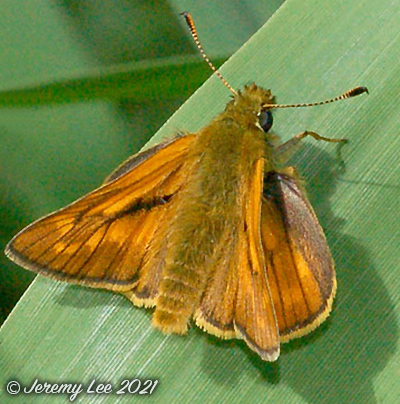
 |
|
Scientific Classifications explained » Amphibians » Ants » Aphids » Bees » Beetles » Birds » Bugs » Butterflies » Caterpillars » Damselflies » Dragonflies » Earwigs » Flies » Frog/Leafhoppers » Fungi » Galls » Grasshoppers » Harvestmen » Hoverflies » Lacewings » Ladybirds » Leaf Mines » Lichens » Mammals » Millipedes » Mosses » Moths » Sawflies » Slugs » Snails » Spiders » Trees » Wasps » Wild Flowers » Woodlice |
UK Nature > Butterflies > Ochlodes venata

Scientific Name: Ochlodes venata Common Name: Large Skipper Ochlodes venata is more commonly known as the Large Skipper; although called 'Large' this is still a relatively small butterfly and not much larger than either the Small or Essex Skippers. The faint chequered pattern on both the upperside and underside help to distinguish the Large Skipper from these two orange Skippers. It can be found anywhere where wild grasses are allowed to grow tall. Hedgerows, woodland clearings and edges are favourites. An active little butterfly in sunny weather it is attracted to various flowers but has a distinct liking for bramble flowers. Eggs are laid singly on the underside of foodplant leaves and hatch after about two weeks. Pupation lasts about three weeks during May and June and the adults are present from June to August. It is the first of the 'grass skippers' to emerge in the UK. |
|

https://www.uknature.co.uk is a website dedicated to showing the immense diversity of UK nature and wildlife. Our vast range of habitats, from lowland arable to snow covered mountains, from storm-ravaged coastlines to peaceful inland freshwater lakes and rivers, from dry, sandy heaths to deciduous and coniferous forests, all these habitats contribute to the abundance of UK nature. We have wild birds in huge numbers either residing or visiting our shores (597 recorded species as at July 2013) and we must also not forget the humble back garden with its grass lawns, flower beds filled with nectar rich flowers, shrubs and trees, all designed to attract huge numbers of insects such as bees, moths, butterflies and hoverflies; and finally the small ponds which provide safe havens for frogs, toads, newts and even slow worms and grass snakes. www.uknature.co.uk is the showcase for my personal passion, photographing uknature in all its glory. I sincerely hope you all enjoy the fruits of my labours. This site and all images contained therein is © Jeremy Lee 2004 - 2021. All Rights Reserved. Site design by Jeremy Lee. Site development & IT Support by Stuart Lee. |